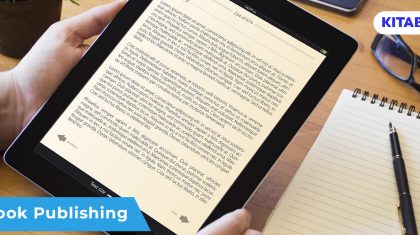
Reflowable vs Fixed: Which is The Best eBook Format? (2024)
An increasing number of people now prefer to access and read books on digital devices such as eReaders, computers, smartphones, and tablets. This makes publishing your book digitally an excellent way to increase your overall reach to a large audience.
But before your publishing moves to eBook status, it needs to be converted into a format that is compatible with most of the electronic devices available in the market.
There are primarily two types of eBook formats available for publishers: reflowable formats and fixed formats.
In order to be able to make the right decision between reflowable vs. fixed-layout format for your ebook, it is important to understand both these formats fully. This guide will help you make the decision faster, even if you are not well-versed in the mentioned formats.
Reflowable or Standard Format: Some Things to Know
Authors of fiction and nonfiction books primarily use the reflowable or standard eBook format. The main reason for the popularity of this format is that it is most suitable for text-heavy books such as novels or nonfiction category narrative books.
Besides, in reflowable format, the lines of text change automatically to match the device on which it is being read and its orientation as well.
The reflowable format also allows readers to customize their eBook for the most convenient and tailored reading experience and can easily change the font, margins, text size, etc.
The reason why this layout works best for text-rich books is that it is easily readable on various eBook devices. In this format, the content reflows to automatically fit the device or screen being used to read the eBook.
Apart from this, since most devices accept this layout, it offers authors a larger distribution opportunity.
Some of the reflowable eBook formats used these days commonly are as follows:
- KPF or Mobi for Kindle (Note-Amazon now accepts ePub format mostly)
- ePub- all well-known retailers and devices use ePub. These include Apple’s iPad and iPhone, OverDrive, and Nook by Barnes and Noble.
Also, remember here that in this format, the appearance of images, tables, embedded fonts, formatted text, and bulleted text will change in appearance. This will depend on factors like the platform, the device on which the ebook is being accessed and viewed, and the individual settings chosen by the reader.
Fixed-layout Formats
The fixed-layout format in eBooks is mostly used for projects with more complex page layouts and where there is a need to have absolutely placed content.
Some examples of fixed-layout used in eBooks are organizational reports, children’s books with detailed illustrations, and cookery books with lots of pictures.
Some of the common fixed-layout eBook formats available today include the following:
- ePUB3 for Google, Apple, and Kobo
- KF8, and Kindle Textbook Creator for Kindle Devices by Amazon
- NOOK Kids and PagePerfect for Barnes & Noble.
Reflowable vs. Fixed-page-Which eBook Format Is Right For You?
To make it easier for you to decide between the two, here is the comparison between the reflowable and fixed layout formats:
Reflowable Formats
Advantages
- a. The key benefit of a reflowable format is that it can change based on the device used and the customized settings selected by the users. The same is streamlined across devices and eBook retailers, thus minimizing the hurdles users encounter to access and read the eBook.
- Offers better distribution opportunities as it is compatible with most devices and platforms
- Much faster to update and give readers full control over how the text is displayed since the layout is presented in an easy-to-use and simple format.
- d. Standard or reflowable layouts are easy to share via files that are smaller in size. The small size of the files ensures that they don’t take up too much space on the reader’s device and are simpler to deliver.
- e. Less expensive to both produce, which means that the simpler the format, the simpler it gets to create and update the file.
Limitations
- The biggest limitation of reflowable format is that such layouts only allow for simple pages, making them an unsuitable option for someone who wishes to add more interactivity to their eBook.
- b. The simple layout of reflowable content allows creators to only access specific fonts and limits the use of any graphic elements or other heavy designs.
- c. In this format, the writer does not have control over how the text appears on screens. This is a big limitation of this format, especially for the users who wish to have higher control over how their ebook content is displayed
Fixed layout
Advantages
- a. In the case of fixed-layout eBooks, the author and content designer enjoy complete control over how various content elements are visible on a screen.
- Fixed layout is the best format for image-heavy books such as graphic novels and cookbooks where design is an important element
- It is the ideal layout to use if the text you want to render has multi-columns and also has specific locations at certain points
Limitations
- a. It may not be the best format for the users as they do not have any control over elements such as fonts, size of the text, spacing, or margins
- b. Relatively expensive and complex format to produce
- c. Not all the ebook readers of distributor chains support this format, which restricts the reach
- d. The fixed layout format tends to have large file size and may attract additional downloads charges on Amazon
Also Read: Convert PDF to Reflowable ePub
Final Verdict: How to Choose
The best way to choose between the two options discussed above is by effectively weighing the reflowable vs. fixed layout format advantages and drawbacks. This will help you decide on the layout that best fits your ebook.
Irrespective of the format you choose from the above two, you can easily create and prepare your eBook using Kitaboo’s online ebook creator tool. You can also hire our ebook conversion services, where professionals take care of preparing your ebook from start to end. To know more, please write to us at contact@kitaboo.com
Suggested Reads:
Discover how a mobile-first training platform can help your organization.
KITABOO is a cloud-based platform to create, deliver & track mobile-first interactive training content.


